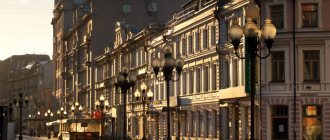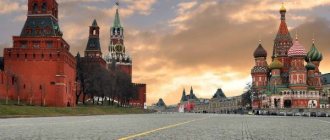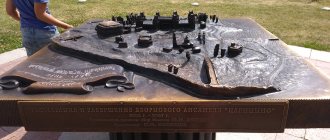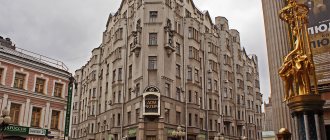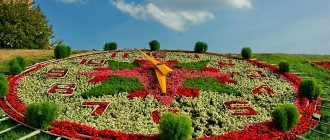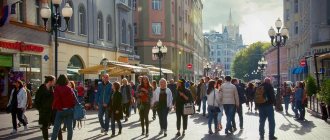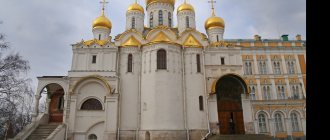Arbat is an ancient Moscow street, now completely pedestrian. People come here for history, because the houses of Arbat remember Alexander Pushkin, Andrei Bely, Bulat Okudzhava.
Here you can plunge into the atmosphere of antiquity and luxury in the perfumery museum, tickle your nerves in the museum of corporal punishment, enjoy music and good cuisine in cafes and restaurants.
We marked all the places mentioned in the article on the map:
History of Arbat
Arbat arose in the XIV-XV centuries, there are a number of versions about the origin of the name of the street:
- Has Arabic origins. "Rabat" literally means "suburb".
- Once upon a time, on this site there was a settlement of carts, where carts, that is, carts, were made. The name was formed from this Mongolian word.
- The word “Arbat” could be Russian and derived from the short adjective “hunchback”, because the streets were built with a curve to reduce the wind.
In the XVI-XVII centuries. Arbat was considered the main road to the Kremlin. For this reason, battles often took place here. In the 16th century this place and the nearby alleys were inhabited by masters of the money court, artisans, and archers. This is how Plotnikov, Denezhny or Levshinsky lanes began to be called.
The fire of 1812 greatly damaged Arbat and made it unrecognizable. Most of the wooden houses burned down entirely. After this incident, a significant proportion of the buildings were built from stone.
By the end of the 19th century, Arbat began to acquire an image similar to the modern one. Shops appeared here and high-rise buildings began to be created. Shop owners become famous throughout Russia: Shustov, Filippov, Eileen.
At the beginning of the 20th century. Arbat received features of such a direction as constructivism. The contours of the streets became smoother, and numerous houses were aligned to the same height. The architects brought the buildings to one gray scale. Most of the aristocratic mansions were transformed into communal apartments.
In the 1930-1950s. Arbat is a path of national significance. In the 60s, a highway was built through the Arbat lanes, called New Arbat, where the state road was moved from the old one. Such actions caused great dissatisfaction among many people, since it was necessary to eliminate significant architectural monuments of the 18th-19th centuries.
In 1974, the street was transformed into a pedestrian zone: shops and restaurants began to open, street musicians began to perform songs, the space was filled with works of novice painters and souvenir shops.
How to get there
Arbat begins with Arbat Gate Square and ends with Smolenskaya Square. The length of the street is 1.2 km.
It is located near the main attractions of Moscow:
- You can get there by metro . You need to take the Filevskaya line. At the very beginning of the street there is a station – “Arbatskaya”, and at the end – “Smolenskaya”.
- Can be reached by bus . The nearest stop is "Metro Smolenskaya", which is served by buses No. 64, 132 and night buses - Bk. Another bus stop, which is located on Novy Arbat, is called “House of Books”. It is reached by buses No. 6, 39 and night buses H2.
"Prague"
This restaurant is one of the symbols of Arbat. The establishment was very popular during the Soviet years. True, not everyone could afford a festive dinner in this restaurant. But in the 19th century, among its visitors there were only cab drivers.
Before the revolution, a large landowner, Vera Firsanova, lived in Moscow. Originally, the building in which the restaurant is located today belonged to this lady. A drinking establishment was opened here and received a name that has remained to this day. True, regular visitors, local cab drivers, then called the restaurant a little differently, in their own way - “Braga”.
Since 1896, the house was owned by Semyon Tararykin, who, unlike the previous owner, appreciated the advantages of the location and opened a first-class restaurant within the walls of this two-story building.
The building underwent its first reconstruction in 1902. The second - two years before the Revolution. After 1917, the restaurant was nationalized. Several shops were located here, and a canteen was opened in 1924. For three decades, the Nekrasov Scientific Library was located in the former apartment building.
The dining room existed until the early thirties. The fact is that at that time the construction of a route began that ran from the Kremlin to Stalin’s dacha near Moscow. Unreliable residents of Arbat were evicted. A canteen with affordable prices has lost its relevance.
In the fifties, another reconstruction of the restaurant was carried out, after which it became the most prestigious establishment in Moscow. There were eight halls here. The best Moscow chefs worked at the Prague restaurant.
What interesting things can you see on Arbat today? There are many ancient buildings here, but among them a special place is occupied by the restaurant, where famous artists once dined. In 1898, Anton Chekhov and the actors of the Moscow Art Theater celebrated the premiere of “The Seagull” here. Leo Tolstoy read chapters from his novel “Sunday” in this establishment. Vladimir Mayakovsky dedicated one of his works to the Prague restaurant.
Sights of New Arbat
Moscow's New Arbat is famous for its many buildings for various purposes, which can be seen at any time.
Temple of St. Simeon the Stylite
One of the ancient churches of Moscow. Russian writers visited it, and popular historical figures got married.
The temple was not destroyed during the construction of New Arbat. Address: Moscow, st. Povarskaya, 5, building 1. Opening hours: daily, 09:00-19:00
USSR Museum
The museum contains numerous items that were made during the Soviet era. The purpose of the museum is to tell about the country through simple things. People who lived during that period will again be able to feel the atmosphere of Soviet life. Address: Moscow, st. Novy Arbat, 15. Opening hours: Mon-Sun 11:00-00:00. Ticket: 250 rub.
Cinema "October"
The facade of the building is decorated with a patterned panel made of natural stone, which is dedicated to the theme of the October Revolution. The painting is listed as a cultural heritage item. The cinema seats more than 3,000 spectators. Various performances take place here from time to time. Address: Moscow, st. Novy Arbat, 24. Opening hours: daily, 09:00-02:00. Ticket: from 300 to 2000 rubles.
Library named after N. A. Dobrolyubov
It is the oldest public library in Moscow. Today it is considered the most modern intellectual platform. Various studios and clubs are located here, literary readings, lectures, and film screenings are held. Address: Moscow, Smolenskaya Square, 13/21.
Opening hours:
- Tue-Sat 10:00-22:00;
- Sun 10:00-20:00.
Ticket: free.
After World War II
The fire of 1812 radically changed the appearance of Arbat. What to see in Moscow? A whole list needs to be given to answer this question, but it will include very few architectural monuments erected before the Patriotic War.
The fire destroyed most of the buildings in Moscow. A year later, a large-scale development project for the city was approved. Stone buildings appeared in place of burnt wooden buildings. Moreover, architects more often resorted to the Russian style, which was widespread in the pre-Petrine era.
Unusual excursions along Arbat in summer
During warm weather, the following events are held:
- "Secrets of Arbat lanes." The guide will share interesting facts about Arbat houses and alleys, where many famous people of all times lived. It will also reveal the secrets of these people. Cost: Without discounts: 400 rub. Students: 350 rub. Pensioners: 350 rub. Schoolchildren: 200 rub. Children under 7 years old: free Duration: 2-2.5 hours.
- "Arbat love triangles". The excursion takes place along the streets of Malaya Nikitskaya, Spiridonovka and neighboring alleys. On these Moscow streets, the love stories of Andrei Bely, Anna Akhmatova, Maria Andreeva, Sergei Yesenin and other famous people took shape. The guide will tell you about these romantic Moscow adventures. Cost: 3000 rub. Duration: 2 hours
Where to stay on Arbat and in the surrounding area
Tourists can stay in hotels or hotels located near Arbat:
- BEAR HOSTELS . Address: Moscow, st. Bolshaya Molchanovka, 23, building 2. Price: 450 rubles/day.
- Hotel Arbat . Address: Moscow, Plotnikov lane, 12. Price: from 5500 to 12000 rubles.
- Mini-hotel Bulgakov . Address: Moscow, st. Arbat, 49. Price: from 3000 rub.
- Davydov Hostel . Address: Moscow, st. Arbat, 25/36. Price: from 850 to 1300 rubles/day.
- AZIMUT Hotel Smolenskaya . Address: Moscow, st. Smolenskaya, 8. Price: from 3500 to 13600 rubles.
Where to eat
There are several catering establishments near Arbat:
- Hard Rock Cafe . Address: Moscow, st. Arbat, 44, building 1. Menu: traditional cocktails, legendary burgers. Price: average bill 1500-2000 rub.
- The Krusty Krab . Address: Moscow, st. Arbat, 4, building 1. Menu: European, American, Italian, mixed cuisine. Price: average bill 350-890 rub.
- Jeffrey's coffee . Address: Moscow, st. Ladozhskaya, 8. Menu: aromatic coffee and desserts. Price: average bill 500-600 rub.
Tourists in Moscow often want to look at the beautiful and unusual alleys of Arbat, stroll along an old street, see something new and capture it in a photograph.
Article design: Oleg Lozinsky
Theater named after Vakhtangov
In the Soviet years, when asked what to see on Arbat, any representative of the intelligentsia recommended, of course, visiting this theater. Unfortunately, dramatic art is not so popular today. But the theater building invariably attracts the attention of tourists leisurely strolling along an ancient Moscow street.
The theater was founded in 1913 as a student drama studio. Professionals were hesitant to take part in this event. Both the actors and directors were students from various Moscow educational institutions. True, a little later, after much persuasion, Stanislavsky’s student Evgeny Vakhtangov came here as a director.
The premiere of the first performance took place in 1920. Later, such outstanding actors as Mikhail Ulyanov, Anastasia Vertinskaya, Vladimir Moskvin and many others played on the stage of the Vakhtangov Theater.
Opposite the Vakhtangov Theater there is a fountain that fully corresponds to the cultural atmosphere that reigns on Arbat. The sculptural composition “Princess Turandot” was installed in the early nineties of the last century. The heroine of Gozzi's tale serves as a symbol of the famous Moscow theater.
